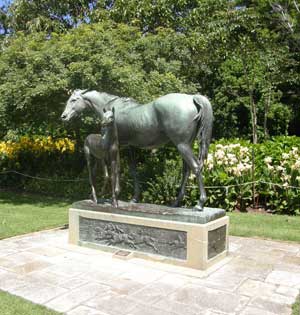Royal Botanical Gardens
Location: Macquarie Street, Sydney
Established in 1916 on the site of the first farm of the young colony of Sydney, the Royal Botanical Gardens contains an impressive collection of native and overseas plants. These include a Palm Grove, which was established in 1862, and features 180 species; a Herb Garden with medicinal, aromatic and culinary herbs from around the world; a Tropical Centre housed in two glass pyramids; the National Herbarium of New South Wales whose collection includes one million dried plant species.
Australia's oldest scientific institution, the Botanical Gardens is still laid out the way Macquarie and Frazer planned it, and features plant specimens collected by Joseph Banks and Captain James Cook on their epic voyage of discovery along the east coast of Australia in 1770; a palm grove, planted in 1862, which features 180 species; a herb garden; a tropical centre in two glass pyramids; the National Herbarium of NSW which houses a collection of over 1 million dried plant specimens; a vegetable garden on the exact site of Gov. Phllips garden containing vegetables similar to what Phillip planted.
Website
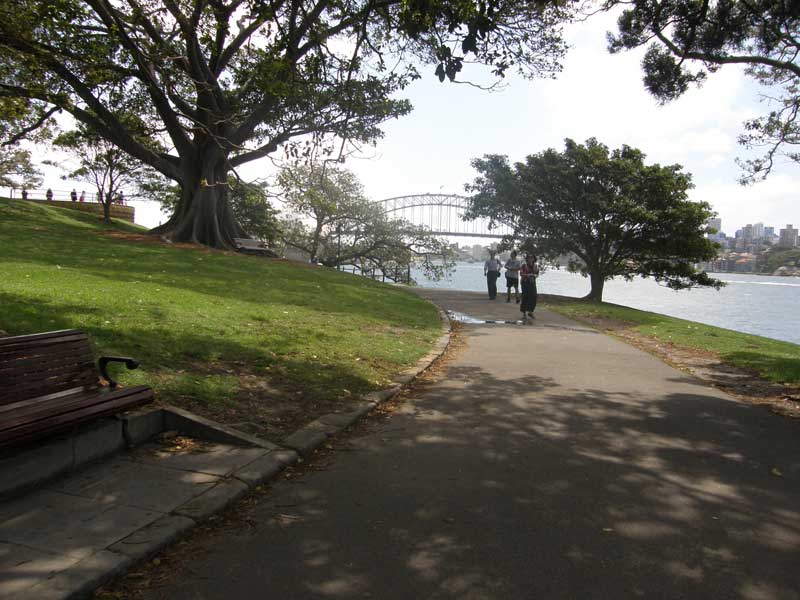
Mrs Macquaries Bushland Walk
Mrs Macquaries Bushland Walk
Along this path by Woolloomooloo Bay, the Gardens' horticulturists have re-created a patch of Sydney's bushland using seed and cuttings from the few small patches of remnant bush along the Harbour's southern foreshores. This is the way Mrs Macquarie may have seen it in 1816 on her way to her Chair at the Point. The botanic Gardens were created around a series of pathways which criss-crossed the domain and emanated from a spot where Captain Arthur Philip had established the colony's first market garden in 1788.
Click on or tap an feature to read the description. Click or tap again to hide the description.
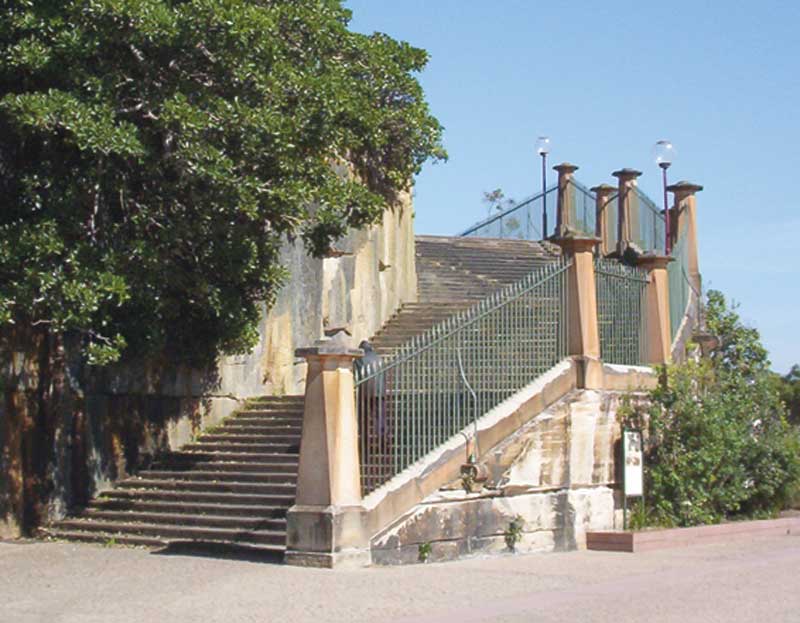
Cut off from the rest of the Domain by the Cahill Expressway, a narrow strip of open parkland runs alongside the eastern side of Macquarie Street and the western boundary of the Royal Botanic Gardens, rising towards the north to encompass the elevated area near Bennelong Point, which overlooks the forecourt of the Sydney Opera House via a rocky escarpment. This area is named the Tarpeian Precinct, after the resemblance of the escarpment to the Tarpeian Rock. This relatively small elevated green space dotted with large trees has views from above to parts of Circular Quay, the Harbour Bridge and the Opera House. Government House is immediately to the south-east of this area.
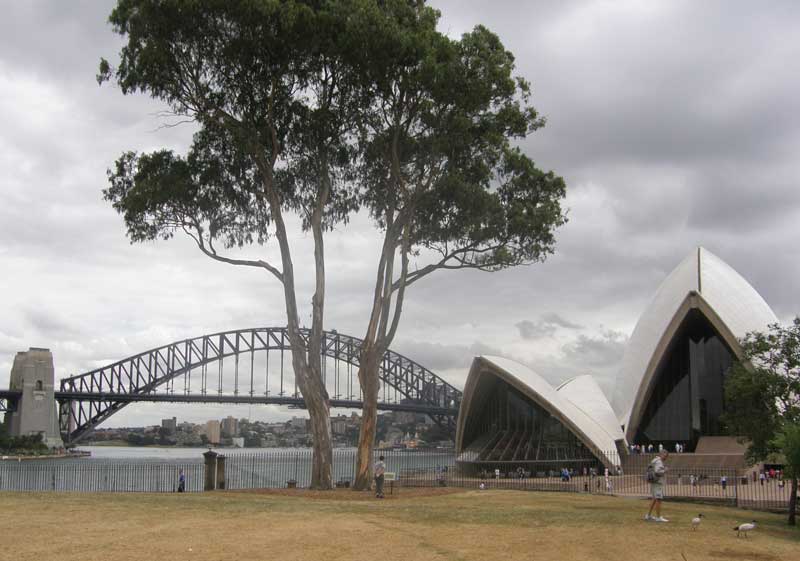
Sydney's city's oldest trees
Two Forest Red Gums in this precinct behind the Sydney Opera House are believed to be the oldest trees in the inner city area. They are also the closest native trees to the centre of Sydney. It is not known if they were alive when the first fleet arrived in 1788 and therefore would actual remants of the natural bushland of the area, or whether they are descendents of original bushland species, as the age of trees of this species is hard to confirm. What is known is that they have been growing there since the 1840s, as they appear on landscape paintings of Sydney from that era.
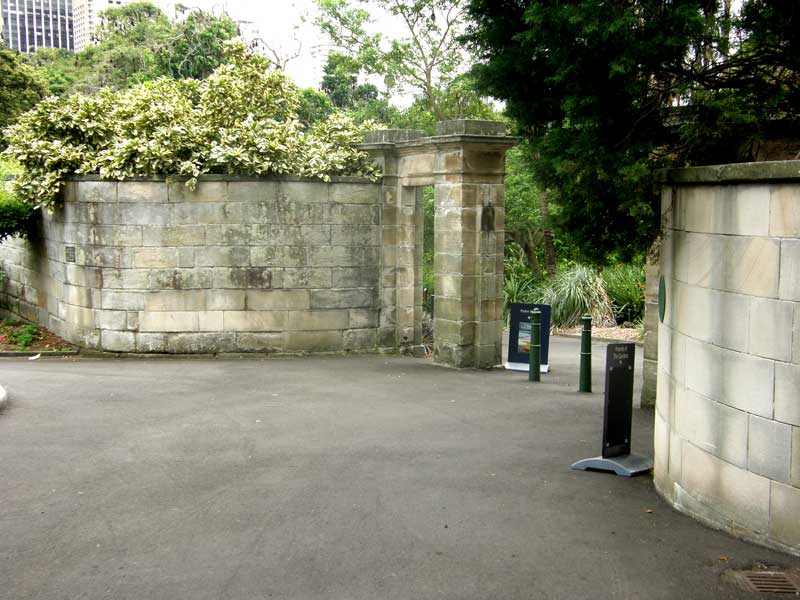
This 290 metre long piece of history is all that remains of a wall built by convicts in 1810 and is the oldest colonial relic is the inner city of Sydney. It was one of the first building projects undertaken by Governor Macquarie after taking up his post as Governor. Within weeks of his arrival, he set aside the land surrounding Farm Cove as a domain for the people of Sydney and ordered the construction of the wall - from Farm Cove to Woolloomooloo Bay - to divide the domain in two halves, one for the convicts and another for the towns Respectable Class of Inhabitants . The Botanic Gardens were created six years later around a series of pathways which criss-crossed the domain and emanated from a spot where Captain Arthur Philip had established the colonys first market garden in 1788.

The Domain occupies the entirety of the peninsula of Mrs Macquaries Point, with Farm Cove to the west and Woolloomooloo Bay to the east. Offering the iconic view of the Sydney Opera House alongisde the Sydney Harbour Bridge, Mrs Macquaries Point is a popular destination for tourists and photographers. Mrs Macquarie's Chair is a stone seat carved out of the rock for Governor Lachlan Macquarie's wife in 1815. Above the chair is an inscription recording the completion of Mrs Macquaries Road on 13th June 1816.
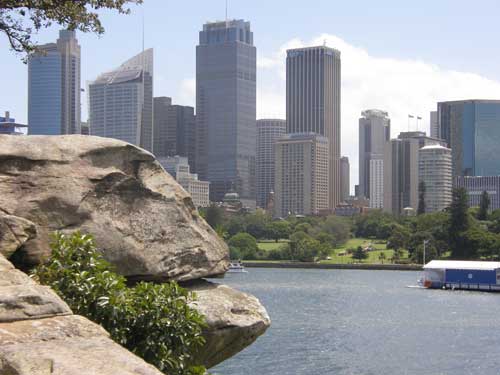
Mrs Macquarie had a hand in designing the newly created Botanical Gardens which leads to the location at Mrs Mascquaries Point. She loved the harbour and often came by carriage to Yurong to sit and look at the harbour. Yurong was the point's aboriginal name. It was earlier known as Anson's Point after John Anson, a carpenter, who held the lease to the farmlet in this area. It was stocked with grafted fruit trees, and advertised for sale in May 1805.

The Fleet Steps, facing Farm Cove, link Farm Cove to Mrs Macquarie Road. The steps are named after the Great White Fleet of the US Navy, and was built for the visit of that fleet to Sydney in 1908. It is the point where Queen Elizabeth II first set foot on Australian soil in 1954, and a commemorative wall plaque marks the event. The site is often used for large marquee functions with stunning views of the Opera House and Harbour Bridge. The name of the steps recalls the fact that the convicts transported to New South Wales with the First Fleet came ashore in the vicinity in January 1788.

Boy Extracting A Thorn: In 1883, a group of eight marble statues were imported from Italy and erected in the Royal Botanical Gardens, Sydney. This group of statues included the Seasons, the Boy extracting the Thorn and La Ballarina, all of which remain the in Gardens today.
La Ballarina: One of a group of eight marble statues were imported from Italy and erected in the Royal Botanical Gardens, Sydney, in 1883. This group of statues included the Seasons, the Boy extracting the Thorn and La Ballarina, all of which remain the in Gardens today. She is a copy of a famous statue by Antonio Canova, the Venetian sculptor who lived from 1757 to 1822, whose work included The Three Graces now in the Hermitage, and Theseus and the Minotaur in the Victoria and Albert Museum. The original of La Ballarina has since disappeared but it is listed in Canovas work as La Danzatrice con il dito al mento (the Dancer with the finger on chin). Finished in 1814 she was sold to a Russian diplomat. La Ballarina was restored and re-instated in the Gardens in 2007 after having lost her head and a foot some time in the 1960s.
The Gardens' copy of La Ballarina was almost certainly sculpted by an Australian, Charles Summers, who although born in Melbourne in 1858, had moved to Rome with his parents aged 11. He ran a successful business reproducing famous sculptures including those of Canova, was said to be friendly with two popes and made regular trips to Australia to sell his wares.
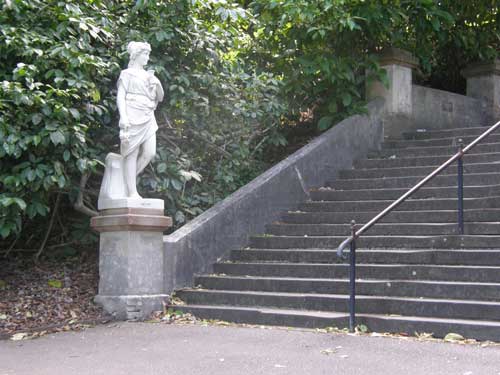
'Winter' at the foot of the Garden Palace Steps
The four 'Seasons' statues: The Four Seasons are part of a long tradition of allegorical figures of the seasons. This tradition dates back at least until the 16th century and the figures are represented in many art forms from paintings by Caravaggio to Meissen figurines. Universal to them all are some key elements as follows:
Winter is always represented by an old man, and the other three seasons by nubile young women
Spring always carries newly cut flowers, Summer holds a scythe and Autumn incorporates a reference to the vintage
Thus in the Four Seasons at the Royal Botanic Gardens, we have Spring holding newly cut roses, Summer with scythe by her side and a swag of lilies, and Autumn with grapes by her side and cup at her lips. Winter allegorically is normally shown as an old man in furs often by a fire. In this case, we have a distinguished if rather dour figure holding symbols of winter in the form of pine cones and a dead bird.
Prior to restoration in 2007, both Summer and Spring had been resident for some time in the Gardens' Graveyard, where damaged statues are stored. Summer had lost her head, and it had been lost as well. Summer's torso had also been broken away from her legs. Spring had been decapitated, and her hands damaged.
All four four Seasons statues now reside at the Garden Palace Steps near Maquarie Street. Winter and Spring stand either side of the bottom of the steps while Summer and Autumn are at the top. Lion Gate Lions: Two impressively carved stone lions guard the Lion Gate in the Macquarie Wall. The lions were bequeathed to the Gardens by Edward Sanders in 1912.
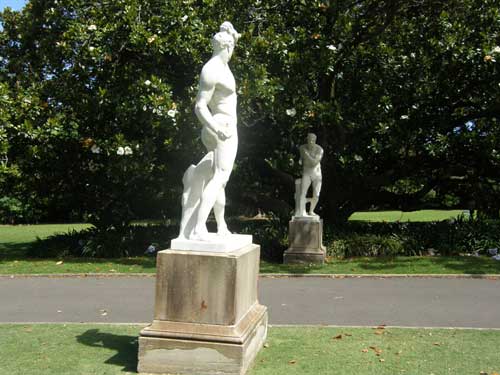
The Boxers statues
The Boxers Statues: A marble copy of the original statues by Italian sculptor Antonio Canova (1802), which reside in The Vatican.
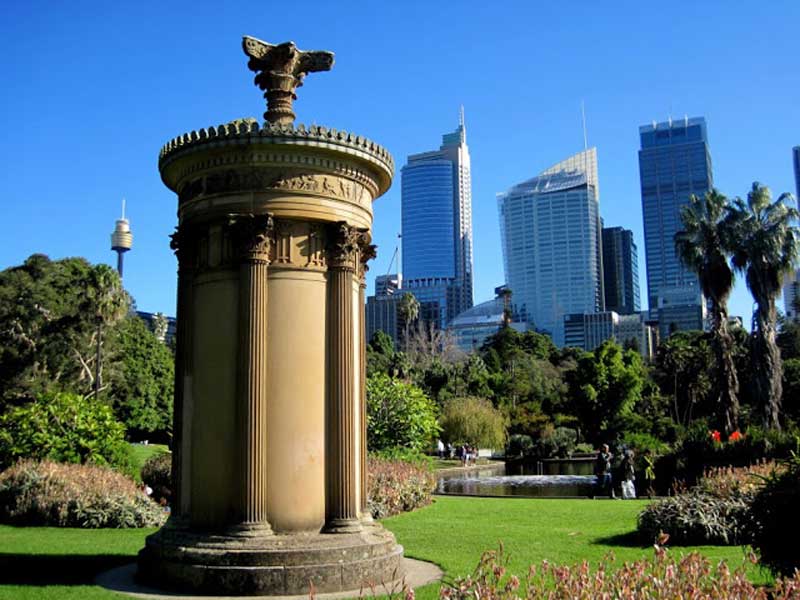
Choragic Monument
Choragic Monument of Lysicrates: This sandstone edifice by is a replica of the eponymous ancient Monument to Lysicrates in Athens, erected 335/34 BC. It was executed by Walter McGill for Sir James Martin, Premier of New South Wales, 1870, for his residence in Macleay Street. Presented to the Royal Botanic Gardens in 1943.

The Huntsman and Dogs
The Huntsman and Dogs: A copper coated cast iron copy of the original by French sculpture Henri Jacquemart (1824-96). It was cast by the Val d'Osne Company c.1879.
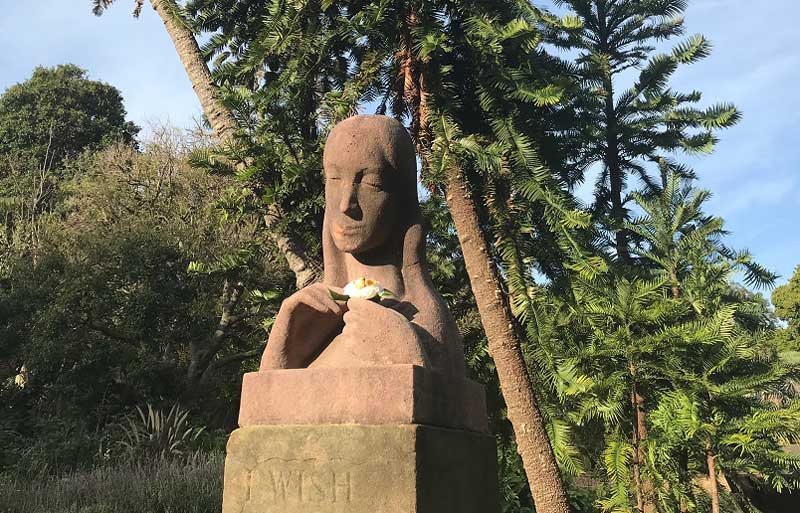
The Huntsman and Dogs
I Wish statue: A pink concrete head of a girl by Arthur Fleischman, commissioned by Leo Buring, and mounted on a sandstone plinth (site of the first Wishing Tree), 1946. One of the few examples of modern art in the Gardens.
Lewis Wolfe Levy Fountain: Levy was a member of the Legislative Assembly. His is remembered with a fountain featuring a bronze nymph holding a Cornucopia (horn of plenty) and four bronze drinking fountains on a brown granite pedestal.
Linda da Chamounix and the Sweep Boy statue: Two characters, with a Hurdy Gurdy, from the Gaetano Donizetti opera, Linda da Chamounix. First performed in 1842. These statues have been in the same place in the Gardens since the 1880s.
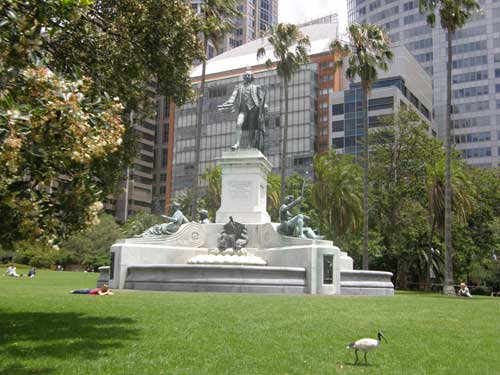
Captain Phillip Monument
Captain Phillip Fountain: A huge fountain, erected in 1897 on the site of the former Garden Palace Exhibition Building after it burnt to the ground. commemorating NSWs first governor, Arthur Phillip, it is the work of Italian sculptor Achille Simonetti, whose work was cast in Florence by F. Galli.
This elaborate fountain/memorial, the only one in Sydney to honour Phillip, was erected as part of the Queen Victoria Jubilee Celebrations. The larger than life statue of Phillip features him holding a scroll, with a flag furled by his side, facing Sydney Heads, perhaps looking for the Second Fleet which took so long coming from England. around the plinth are white marble basins with water jets, bronze reliefs representing Patriotism, Education and Justice, flanked by Agriculture, Cyclops, Commerce and King Neptune. To complete the picture are paired dolphins and bronze plaques featuring Aborigines.

Allan Cunningham Monument
Allan Cunningham Monument: Located near the Gardens Restaurant in the Botanical Gardens is a sandstone obelisk to Allan Cunningham, the Gardens Superintendent in 1837. A botanist and explorer, he is credited with having discovered Queenslands Darling Downs. His ashes are buried beneath the monument.
Magnolia and Palm: The pair of over scaled seed-like sculptures nestled beneath a magnolia and a palm tree in the Gardens are placed adjacent to the site of the First Farm in Sydney Cove. The forms reflect the organic flotsam washed up by the tide, blown by the wind and laden with the potential for transformation and new life. Created by Bronwyn Oliver.
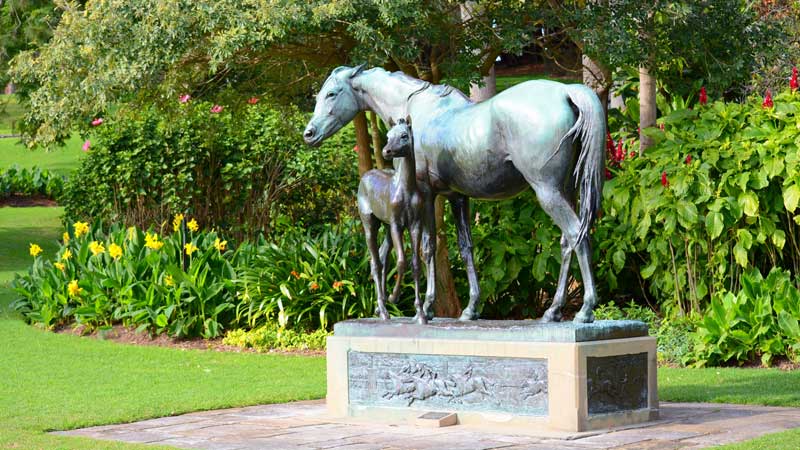
Mare and Foal: Bronze mare (La Reyna) and her foal by the French artist, Arthur J. le Duc, purchased in 1891, and donated to the Royal Botanic Gardens in 1958.
Earth Mother: Figurative sculpture by Helen Leete, from earth and sand laid in strata, imitating natural rock, 1993.
Venus Italica: Marble replica of the Venus Italica (Italian Venus) by the Italian sculptor Antonio Canova. Canovas Italian Venus was commissioned as a replacement for the famous Medici Venus which had been seized by Napoleon in 1802 and removed to the Louvre. (It was eventually returned.) The Medici Venus is itself a 1st century BC copy of a work by Cleomenes of Athens. Its popularity meant that a number of replicas were made, but how many is unclear. Rather than copying directly from the antique, Canova would form the clay model from which a plaster cast was made, which he considered to be the original work of art. His assistants then copied the form accurately in marble with the aid of a pointing compass.
Satyr: Bronze cast of Frank 'Guy' Lynch's 1924 sculpture modelled from the artist's brother, whose death inspired Kenneth Slessor to write his poem 'Five Bells', 1977.
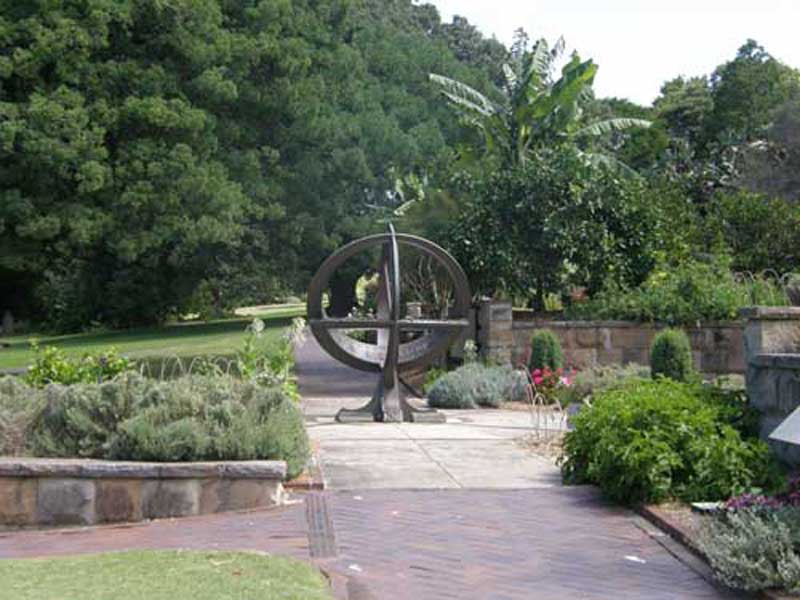
Allan Cunningham Monument
Herb Garden Sundial: A splendid armillary sphere sundial, 2.4 m tall, 1.5 m internal ring diameter, weighing 1500 kg and made of silicon bronze, was designed specifically for the Herb Garden by John Ward and Margaret Folkard in 1994. Features herbs modelled in clay in high relief by Adelaide sculptor Karen Rumpf from drawings by Gardens' illustrator Marion Westmacott. Both sundial and herb ring were cast by Dave Mune at the Art Foundry in Victoria. The sundial is dedicated to the memory of Lieut. Nigel Malcolm Hardy Arnott (1910-1991), an admirer of the Botanic Gardens.
The hours from 6am to 6 pm are marked with 10 minute divisions on the inside of the tapered equatorial ring. The horizontal ring is magnificently decorated with an arrangement of 38 different kinds of herbs (including coffee!) sculpted in three dimensions and cast integrally into the ring. Look for a very special parrot hidden away in the herbs! Two plaques at the base of the dial give a time correction graph and the history of the donation of the dial.
Herb Garden Bird Bath: Designed and made in 1994 for the Herb Garden by sculptor Peter Mueller and commemorating Hope Clayton (1907-1991), a friend of the Gardens.
Daniel Solander bust and monument: Commemorates the first visit to Australian by a Swede. Solander was a member of James Cook's expedition aboard HMS Endeavour, which visited Botany Bay in April 1770. Solander was a leading botanist of his day. The monument was unveiled in 1982 by the King of Sweden, Carl XVI Gusaf, while visiting Australia. Another monument to Solander stands at Captain Cook's Landing Place in Kurnell near where Solander first came ashore
Sensory Fountain: A spherical fountain designed to be touched, seen and heard - water begins to flow as you approach. Designed for the Herb Garden in 1994 by Victorian artist Tim Jones and made by Dave Mune at the Art Foundry in Victoria. The fountain is surrounded by a bronze ring of herbs drawn by Gardens' illustrator Marion Westmacott. Donated by the Australian Bank Ltd to commemorate their 10th anniversary and the 175th anniversary of the Royal Botanic Gardens.
Wuganmagulya (Farm Cove): Wuganmagulya (Farm Cove) commemorates the historical and contemporary presence and importance of indigenous people to this part of Australia. In two sections of the pathway, figures from Sydney rock carvings - some of which no longer exist - are depicted in terrazzo and stained concrete using colours that reference the natural elements of the surrounding environment. Along the pathway kerb, the names of women and men, places, animals, tools and rituals from the many indigenous clans and language groups in the Sydney area are etched in red. The artwork pays homage to the Yura - the original clans of the site - as well as the clans who travelled great distances to attend ceremonies at Sydney Cove. It also acknowledges recent indigenous history such as the 1988 Long March of Peace, Justice and Hope. Created by Brenda L. Croft.
Pioneer Women Memorial: A small bronze figure, erected in 1938, and created by British artist Paul Montford (1868-1938) located in the Memorial Garden to the Pioneer Women. The garden is built on the site of the Garden Palace Exhibition Building which was erected in 1879 to house the international exhibition of 1879.
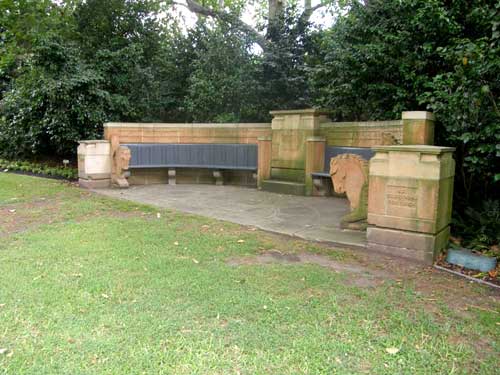
Henry Kendall Seat
Henry Kendall Seat: This Art Deco style seat dedicated to Australian poet Henry Kendall was provided under the bequest of Mrs. A M Hamilton-Grey, an admirer of his poetry and was erected in 1940. The winged horses were carved by L. Bicego, 1939.
Folly for Mrs Macquarie: Lachlan Macquarie and his wife governed in Sydney from 1810 to 1821. They arrived with a pattern-book for buildings in the neo-classical style and a desire to transform the colony. A sketch from the period indicates that Mrs. Macquarie had a folly constructed and that it stood at or near the location of this folly.
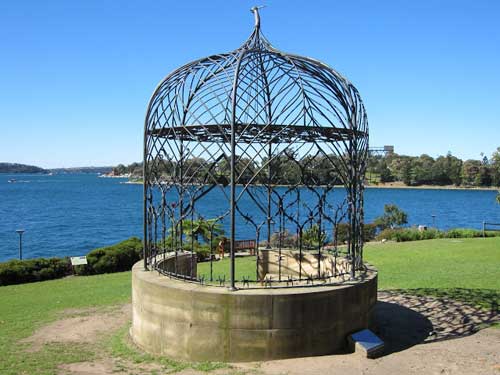
Folly for Mrs Macquarie
The design elements in Folly for Mrs. Macquarie echo those early aspirations, but also remind us that there was much folly in the way Britain colonised Australia. For example: the domed roof of Norfolk Island pine fronds refers to the colonists' regard for the tree, only to discover that its brittle timber was entirely unsuitable for ship masts; the ceiling is made from the bones and skulls of animals that once lived in the area; and the "Gothic windows" represent the barbed wire that divided up the land. Created by Fiona Hall. Location: Lawn 62, Botanical Gardens.

Before the arrival of white men, the tidal flats of Farm Cove were used by the local aborigines for their initiation ceremonies of the young males. The gardens are located on part of a large area set aside for public use in 1788 by Gov. Phillip which incorporated all land to the East of the towns eastern ridge (Macquarie Street) to Wooloomooloo Bay from the Harbour south to the present Central Railway Station.
Known to the natives as Wocanmagully, its colonial name was Farm Cove as it was on 30 hectares of land cleared and cultivated in the early months of 1788 that Gov. Phillip and his colony looked towards for their future food supply. While the vegetables they planted grew well, such could not be said for the cereal crops which, being planted in the middle of summer, either failed to germinate or withered and died under the hot Summer sun. The use of the Farm Cove site for vegetables continued until the arrival of Gov. Macquarie whose vision for Sydney included the landscaping of the land around the Farm Cove plantation. In 1816, Australias first botanist, Charles Frazer, laid out the designer gardens of the Botanical Gardens to the requirements of Gov. and Mrs Macquarie, which included the damming of a small creek which flowed into the cove to form the gardens ponds. The mud flats were filled in, however the seawall we see today was not constructed until much later (1848 - 1879).
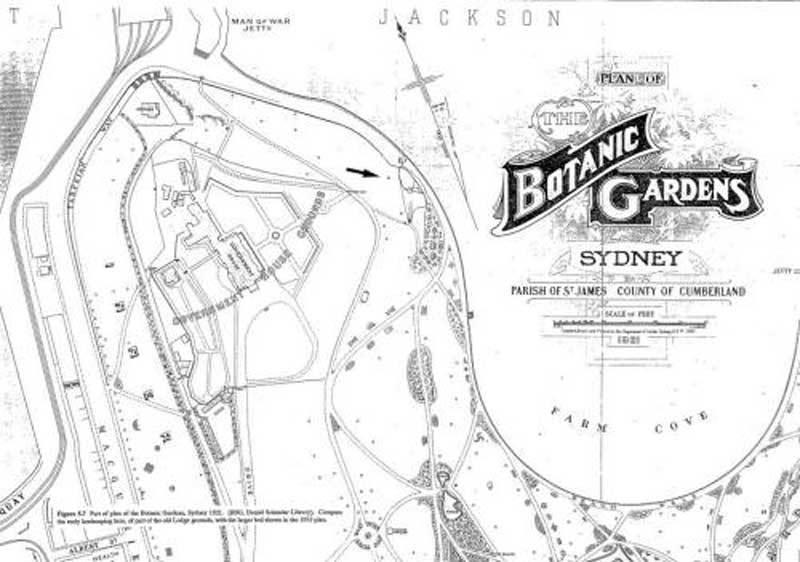
Governor's Bathing House
Now known largely as an area for enjoyable walks in the gardens, the shores around Sydney Cove and Farm Cove used to provide suitable bathing areas. In an age when running water in homes was unknown such a bathe was a means of washing and refreshment as well as enjoying the sea. While no new Government residence was erected, by 1828 a bathing house for the governor was constructed in the Gothic style on the foreshore of farm cove (arrow, map above). It was constructed in the popular Gothic style, during the governorship of Ralph Darling, between 1826 and 1828 or 1829. The Building was constructed entirely of stone found on the spot, having a castellated appearance to the water to correspond in some degree with Fort Macquarie on Bennelong's Point, which is in view, and at a short distance. It was demolished in 1879.
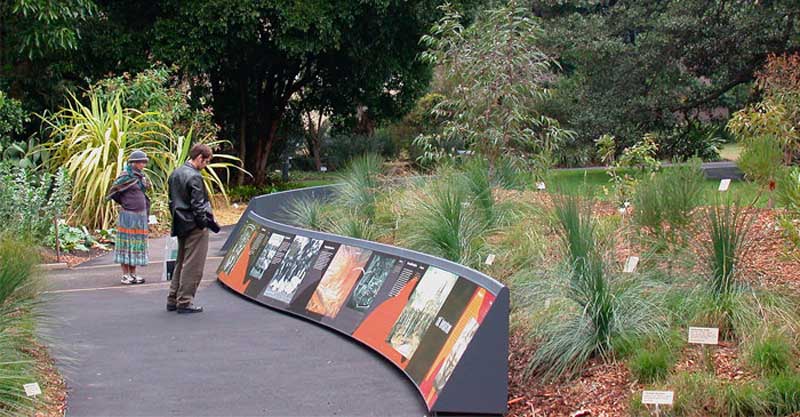
Discover the Gardens' rich Aboriginal heritage. Cadi Jam Ora: First Encounters is a garden display that tells the story of the Cadigal people, the traditional Aboriginal owners of the Sydney city area, and features plants that originally grew on the site of the Royal Botanic Garden. The First Farm display attempts to replicate the first farm established on that very spot by the First Fleeters. Interpretive signs tell the story of the first farm.






